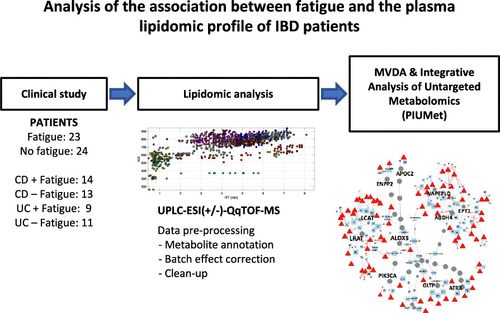当前位置:
X-MOL 学术
›
J. Proteome Res.
›
论文详情
Our official English website, www.x-mol.net, welcomes your
feedback! (Note: you will need to create a separate account there.)
Analysis of the association between fatigue and the plasma lipidomic profile of inflammatory bowel disease patients.
Journal of Proteome Research ( IF 3.8 ) Pub Date : 2020-09-24 , DOI: 10.1021/acs.jproteome.0c00462 Diana Horta 1, 2 , Marta Moreno-Torres 3 , María José Ramírez-Lázaro 1, 4 , Sergio Lario 1, 4 , Julia Kuligowski 5 , Juan Daniel Sanjuan-Herráez 6 , Guillermo Quintas 6, 7 , Albert Villoria 1, 2, 4 , Xavier Calvet 1, 2, 4
Journal of Proteome Research ( IF 3.8 ) Pub Date : 2020-09-24 , DOI: 10.1021/acs.jproteome.0c00462 Diana Horta 1, 2 , Marta Moreno-Torres 3 , María José Ramírez-Lázaro 1, 4 , Sergio Lario 1, 4 , Julia Kuligowski 5 , Juan Daniel Sanjuan-Herráez 6 , Guillermo Quintas 6, 7 , Albert Villoria 1, 2, 4 , Xavier Calvet 1, 2, 4
Affiliation

|
Inflammatory bowel disease (IBD) is a chronic, relapsing noninfectious inflammatory condition of the intestinal tract with two main phenotypes, ulcerative colitis (UC) and Crohn’s disease (CD), and globally increasing incidence and prevalence. Nearly 80% of the IBD patients with active disease and 50% of those with inactive disease suffer fatigue with significant impairment of their quality of life. Fatigue has been associated with multiple factors in IBD patients but, in most cases, no direct cause can be identified, and risk factors in clinically quiescent IBD are contradictory. Furthermore, as the assessment of fatigue is subjective, there is an unmet clinical need for fatigue biomarkers. In this explorative study, we analyzed the plasma lipidomic profiles of 47 quiescent UC and CD patients (23 fatigued, 24 nonfatigued) using ultraperformance liquid chromatography–time-of-flight mass spectrometry (UPLC–TOFMS). The results showed changes in lipids associated with fatigue and IBD. Significantly decreased levels of phosphatidylcholines, plasmanyls, sphingomyelins, lysophosphatidylcholines, phosphatidylethanolamines, phosphatidylinositols, phosphatidylserines, and eicosanoids were observed in patients with fatigue. Network and metabolic pathway analysis indicated a dysregulation of the arachidonic acid and glycerophospholipid metabolisms and the sphingolipid pathway. The protein–metabolite interaction network showed interactions between functionally related metabolites and proteins, displaying 40 disease-associated hidden proteins including ABDH4, GLTP, and LCAT.
中文翻译:

分析炎症性肠病患者疲劳与血浆脂质组学之间的关系。
炎症性肠病(IBD)是一种慢性复发性肠道非感染性炎症性疾病,有两种主要表型,溃疡性结肠炎(UC)和克罗恩病(CD),在全球范围内发病率和患病率均在增加。患有活动性疾病的IBD患者中有将近80%,患有非活动性疾病的IBD患者中有50%患有疲劳,严重损害了他们的生活质量。在IBD患者中,疲劳与多种因素有关,但在大多数情况下,无法确定直接原因,并且临床上静止的IBD的危险因素是相互矛盾的。此外,由于疲劳评估是主观的,因此对疲劳生物标记物的临床需求尚未得到满足。在这项探索性研究中,我们分析了47名静态UC和CD患者(23名疲劳,使用超高效液相色谱-飞行时间质谱仪(UPLC-TOFMS)进行分析(24个无疲劳)。结果显示与疲劳和IBD相关的脂质变化。在疲劳患者中,观察到磷脂酰胆碱,血浆磷脂酰鞘氨醇,鞘磷脂,溶血磷脂酰胆碱,磷脂酰乙醇胺,磷脂酰肌醇,磷脂酰丝氨酸和类二十烷酸水平显着降低。网络和代谢途径分析表明花生四烯酸和甘油磷脂代谢和鞘脂途径失调。蛋白质-代谢物相互作用网络显示了功能相关代谢物与蛋白质之间的相互作用,显示出40种与疾病相关的隐藏蛋白质,包括ABDH4,GLTP和LCAT。结果显示与疲劳和IBD相关的脂质变化。在疲劳患者中,观察到磷脂酰胆碱,血浆磷脂酰鞘氨醇,鞘磷脂,溶血磷脂酰胆碱,磷脂酰乙醇胺,磷脂酰肌醇,磷脂酰丝氨酸和类二十烷酸水平显着降低。网络和代谢途径分析表明花生四烯酸和甘油磷脂代谢和鞘脂途径失调。蛋白质-代谢物相互作用网络显示了功能相关代谢物与蛋白质之间的相互作用,显示出40种与疾病相关的隐藏蛋白质,包括ABDH4,GLTP和LCAT。结果显示与疲劳和IBD相关的脂质变化。在疲劳患者中,观察到磷脂酰胆碱,血浆磷脂酰鞘氨醇,鞘磷脂,溶血磷脂酰胆碱,磷脂酰乙醇胺,磷脂酰肌醇,磷脂酰丝氨酸和类二十烷酸水平显着降低。网络和代谢途径分析表明花生四烯酸和甘油磷脂代谢和鞘脂途径失调。蛋白质-代谢物相互作用网络显示了功能相关代谢物与蛋白质之间的相互作用,显示出40种与疾病相关的隐藏蛋白质,包括ABDH4,GLTP和LCAT。在疲劳患者中观察到磷脂酰肌醇,磷脂酰丝氨酸和类花生酸。网络和代谢途径分析表明花生四烯酸和甘油磷脂代谢和鞘脂途径失调。蛋白质-代谢物相互作用网络显示了功能相关代谢物与蛋白质之间的相互作用,显示出40种与疾病相关的隐藏蛋白质,包括ABDH4,GLTP和LCAT。在疲劳患者中观察到磷脂酰肌醇,磷脂酰丝氨酸和类花生酸。网络和代谢途径分析表明花生四烯酸和甘油磷脂代谢和鞘脂途径失调。蛋白质-代谢物相互作用网络显示了功能相关代谢物与蛋白质之间的相互作用,显示出40种与疾病相关的隐藏蛋白质,包括ABDH4,GLTP和LCAT。
更新日期:2020-09-24
中文翻译:

分析炎症性肠病患者疲劳与血浆脂质组学之间的关系。
炎症性肠病(IBD)是一种慢性复发性肠道非感染性炎症性疾病,有两种主要表型,溃疡性结肠炎(UC)和克罗恩病(CD),在全球范围内发病率和患病率均在增加。患有活动性疾病的IBD患者中有将近80%,患有非活动性疾病的IBD患者中有50%患有疲劳,严重损害了他们的生活质量。在IBD患者中,疲劳与多种因素有关,但在大多数情况下,无法确定直接原因,并且临床上静止的IBD的危险因素是相互矛盾的。此外,由于疲劳评估是主观的,因此对疲劳生物标记物的临床需求尚未得到满足。在这项探索性研究中,我们分析了47名静态UC和CD患者(23名疲劳,使用超高效液相色谱-飞行时间质谱仪(UPLC-TOFMS)进行分析(24个无疲劳)。结果显示与疲劳和IBD相关的脂质变化。在疲劳患者中,观察到磷脂酰胆碱,血浆磷脂酰鞘氨醇,鞘磷脂,溶血磷脂酰胆碱,磷脂酰乙醇胺,磷脂酰肌醇,磷脂酰丝氨酸和类二十烷酸水平显着降低。网络和代谢途径分析表明花生四烯酸和甘油磷脂代谢和鞘脂途径失调。蛋白质-代谢物相互作用网络显示了功能相关代谢物与蛋白质之间的相互作用,显示出40种与疾病相关的隐藏蛋白质,包括ABDH4,GLTP和LCAT。结果显示与疲劳和IBD相关的脂质变化。在疲劳患者中,观察到磷脂酰胆碱,血浆磷脂酰鞘氨醇,鞘磷脂,溶血磷脂酰胆碱,磷脂酰乙醇胺,磷脂酰肌醇,磷脂酰丝氨酸和类二十烷酸水平显着降低。网络和代谢途径分析表明花生四烯酸和甘油磷脂代谢和鞘脂途径失调。蛋白质-代谢物相互作用网络显示了功能相关代谢物与蛋白质之间的相互作用,显示出40种与疾病相关的隐藏蛋白质,包括ABDH4,GLTP和LCAT。结果显示与疲劳和IBD相关的脂质变化。在疲劳患者中,观察到磷脂酰胆碱,血浆磷脂酰鞘氨醇,鞘磷脂,溶血磷脂酰胆碱,磷脂酰乙醇胺,磷脂酰肌醇,磷脂酰丝氨酸和类二十烷酸水平显着降低。网络和代谢途径分析表明花生四烯酸和甘油磷脂代谢和鞘脂途径失调。蛋白质-代谢物相互作用网络显示了功能相关代谢物与蛋白质之间的相互作用,显示出40种与疾病相关的隐藏蛋白质,包括ABDH4,GLTP和LCAT。在疲劳患者中观察到磷脂酰肌醇,磷脂酰丝氨酸和类花生酸。网络和代谢途径分析表明花生四烯酸和甘油磷脂代谢和鞘脂途径失调。蛋白质-代谢物相互作用网络显示了功能相关代谢物与蛋白质之间的相互作用,显示出40种与疾病相关的隐藏蛋白质,包括ABDH4,GLTP和LCAT。在疲劳患者中观察到磷脂酰肌醇,磷脂酰丝氨酸和类花生酸。网络和代谢途径分析表明花生四烯酸和甘油磷脂代谢和鞘脂途径失调。蛋白质-代谢物相互作用网络显示了功能相关代谢物与蛋白质之间的相互作用,显示出40种与疾病相关的隐藏蛋白质,包括ABDH4,GLTP和LCAT。











































 京公网安备 11010802027423号
京公网安备 11010802027423号